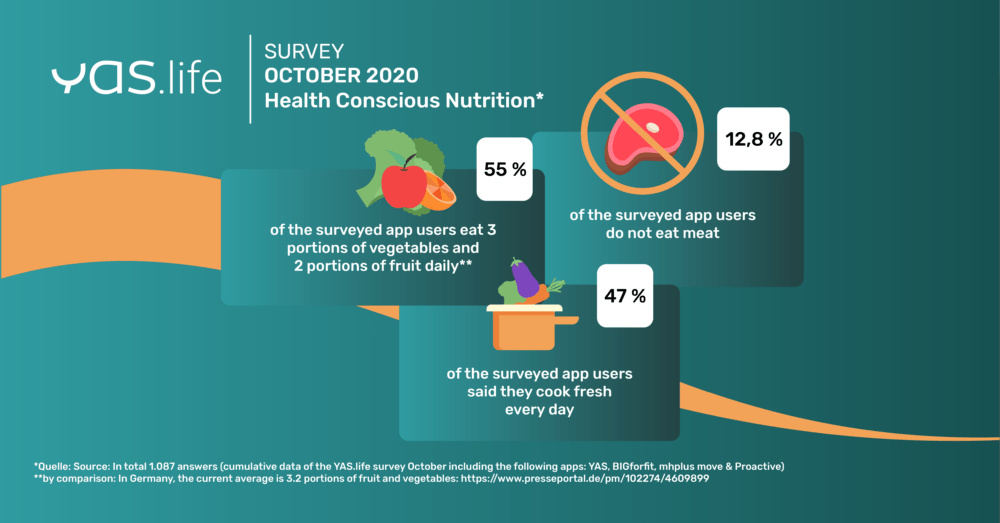
What is a healthy diet? - User survey Healthy diet
How healthy do our users eat? In October 2020, we took up the topic of “healthy eating” in our survey.
What is a healthy diet? A healthy life requires more than just exercising regularly and getting enough sleep. A balanced diet is the be-all and end-all. The body needs to be supplied with all the necessary macro-nutrients (carbohydrates, fats and protein) and micro-nutrients (vitamins and minerals) to function normally. We started a survey on the topic of healthy nutrition and were able to collect interesting results.

Diet with fruit and vegetables: Can it be something fresh?
Fruit and vegetables are part of a healthy diet. Our nutrition chart shows, among other things, that slightly more than half of the app users surveyed adhere to the recommendation of the German Nutrition Society (Deutsche Gesellschaft für Ernährung e.V.). This suggests five portions of fruit and vegetables per day. Of these, three portions of vegetables (around 400 grams) and two portions of fruit (around 250 grams) should be consumed. Fruits and vegetables are usually high in water and low in calories, which makes them the perfect side dish at lunch or a healthy snack in between meals. The healthiest vegetables are peppers with their high vitamin C content, kale and broccoli. The latter contains a large amount of antioxidants, which protect our body’s cells. They are also found in many types of fruit, such as blueberries, apples and strawberries. The additional vitamin C supports our immune system, counteracts fatigue and helps absorb other nutrients such as iron and calcium. But not every fruit and vegetable is in season all year round. Here, you can safely turn to the frozen alternative, because even after shock freezing, all the nutrients and vitamins remain contained.
Renunciation of meat: How many of our app users live without meat?
In the graph on nutrition, we see that almost 13% of our respondents abstain from meat. This may be due to various reasons, but mostly the health aspect is decisive. A high meat consumption has negative effects on our body. Rheumatism, diabetes, arthrosis and cardiovascular diseases can be triggered or aggravated by it. Our intestinal flora, which makes a significant contribution to the functioning of our immune system, can also be disturbed. (2) In comparison, we see that according to statistics, meat consumption in Germany is tending to decrease. In 1993 it was 7.7 million tonnes, in 2021 it was 6.8 million tonnes. (2a). Meat should be chosen and consumed with care. Red meat provides a lot of iron, but white meat is generally considered healthier because it is low in fat and calories. You can find out how much meat should be consumed in the section “What is healthy eating anyway?”.
Cooking fresh: A wish of many of our app users
Home-cooked food still tastes best. Unfortunately, there is often not enough time to cook, but it is all a question of organisation, because where there is a will, there is a way. In the healthy eating survey, almost half of the respondents already cook for themselves every day. This brings some health benefits, because according to one study, it means less sugar, fat, salt and preservatives are consumed. (3)
Asking yourself the question every day: What am I cooking today? This can sometimes be difficult, but recipe ideas from cookbooks or blogs can help. If you don’t like to cook and don’t have the time in your free time, you can get together with friends and cook together. You can learn to cook from each other and with each other, exchange ideas about dishes, spend time together and in the end enjoy a delicious and healthy meal together.
What is actually a healthy diet?
Tastes and tolerances vary and it can be difficult to find your way through the nutritional jungle. What is a healthy diet? The food pyramid is a simple representation of how a balanced diet is made up. In the lowest and most important place is liquid. Every day, adults should drink 1.5-2L of water or other unsweetened beverages such as tea. Right after that comes fruit and vegetables. As already mentioned, three to five servings are recommended here, with one serving corresponding to about a handful. Cereals, for example in the form of pasta or bread, or potatoes belong to every main meal, according to the pyramid. Low-fat meat products, on the other hand, should be eaten no more than twice a week. Low-fat dairy products such as yoghurt and quark (low-fat) may be eaten daily. For vegetable oils, such as margarine, rapeseed oil and nuts, the recommended amount is 1-2 tablespoons per day. Last but not least, snacks that are high in fat, sugar and salt should only be eaten in small amounts. (4)
Healthy eating methods
Nutrition is something very individual, with a wide variety of goals: Losing or gaining weight, building muscle, disease prevention and and and. Eating a vegetarian or vegan diet, for example, can have health reasons as well as ethical, religious and ecological ones. Here, meat and fish or all animal products are dispensed with. In recent years, this diet has become more and more popular, which is also noticeable in supermarkets and restaurants. Meat-free alternatives do not only have to consist of tasteless tofu, but are now more diverse than ever and also healthy.
Sources
About the author

Marketing Assistant
I provide information about the latest developments at YAS.life and give interesting insights into the Digital Health industry. My topics: Digital Health, products at YAS.life, the healthy lifestyle.
If you have any questions or suggestions, I look forward to hearing from you: annalena@yas.life
Follow us for more news on bKV, employer branding and digital health

